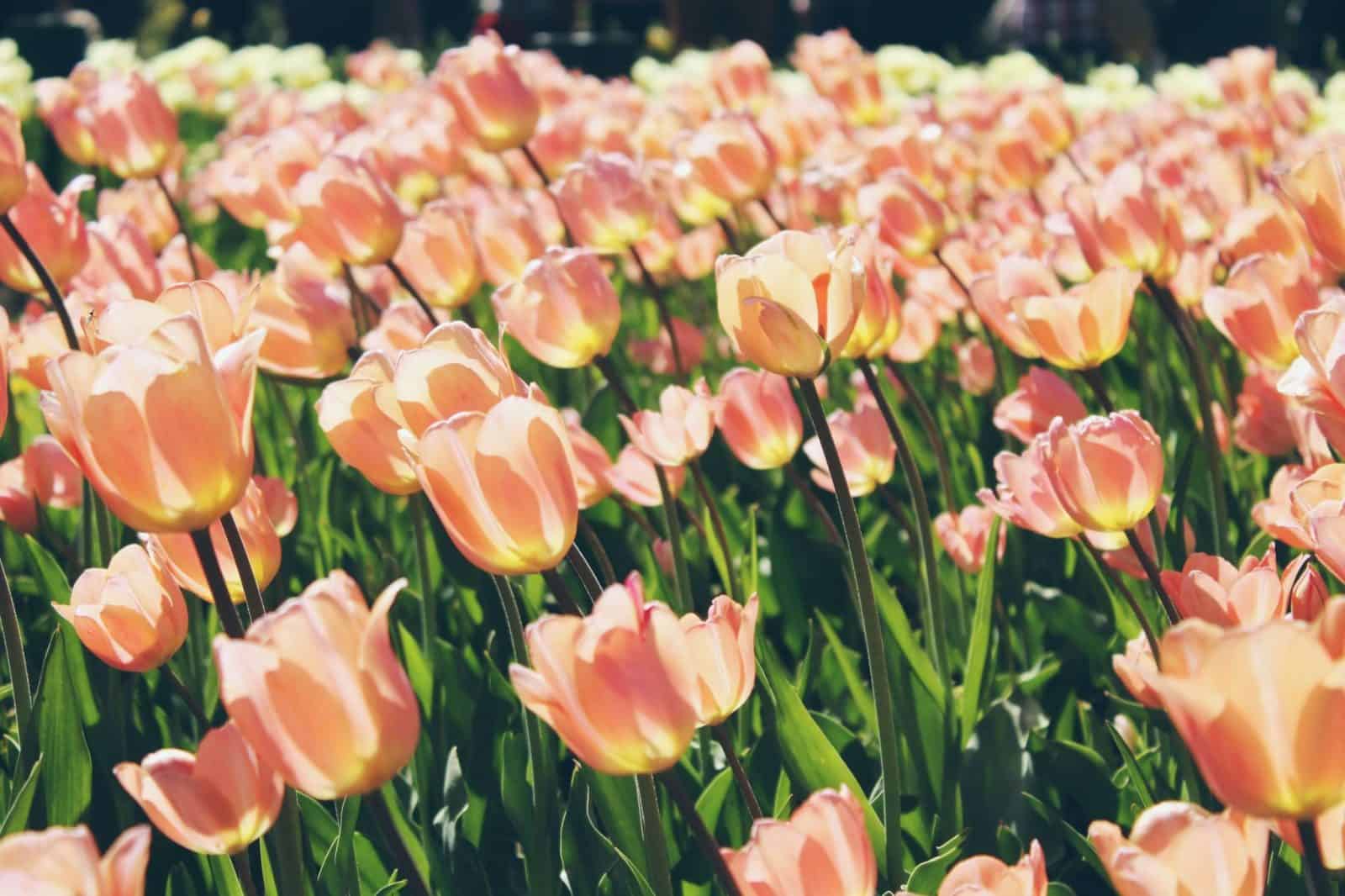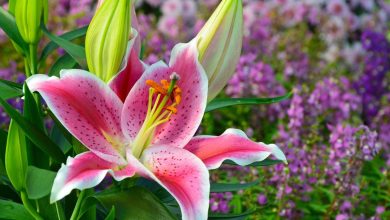How to Plant Tulips and Have a Spectacular Garden: [12 Steps + Images]

Did you know that one ofthe most notorious financial bubblesof the story he starred in the tulips?
You are right. In 17th century Holland, people started going crazy for tulips. The bubble peaked whenhe sold a house for a tulip!
Amazing, right?
I’m sorry, but it’s hard to get rich selling tulips nowadays. Although you can have an impressive garden.
- How often and how to water my tulips?
- When to Grow Tulips: [Temperature and Hemisphere]
- Pests and Diseases of Tulips: [Detection, Causes and Solutions]
Important points when planting tulips:
- When? during the fall, when the weather has warmed and the nights have gotten colder.

- Where? Moderate light area.
- How do we prepare the land? It is not very demanding regarding the substrate. Loose, soft soils, rich in organic matter and with good drainage.
- How do we water? Ideal with drip. It does not tolerate waterlogging well and requires constantly moist soil.
- How do we sow? Here step by step.
- Favorable associations? The garlic cloves.
- Plagues and diseases? Aphids, nematodes, Tulip Fire, Fusariosis, Sclerotia Disease.
Tulips are bulbous plants widely used for decorating gardens and other spaces, thanks to their incredible diversity and their ability to survive, which ensures their flowering.
One of its main characteristics is that to liveThey depend on an underground stem.
Their organs are adapted to conserve the moisture and nutrients necessary to survive in adverse conditions, such as drought and intense heat, allowing them to remain in a dormant state underground with almost no light.
This reserve of nutrients allows her to start a new flowering cycle once again when conditions are favorable again.
When to grow tulips? The dates
let’s plant tulipsDuring autumn, when the weather has warmed up and the nights have gotten colder.
It is recommended to plant the bulbs before the first frost, so that the soil is not so hard.
Where do we plant our tulips? The temperature and the light
Bulbs should be planted when soil temperatures are between13 and 16°C
This is particularly important, since the temperature of the soil has a direct impact on the duration of the crop.
Tulips resist low temperatures very well and are less tolerant of warmer climates.
Very high temperatures increase the possibility of attack by Fusarium oxysporum.
They are not picky about lighting.
In areas with high light incidence and high temperatures, flowering is advanced, which causes the tulips to reach a smaller height.
To avoid this you can limit the light exposure times and use shading.
How will we water? Humidity
 The soil should be moist, but not soggy.
The soil should be moist, but not soggy.
Waterlogging causes the bulbs to rot.
The tulip requires a high level of humidity, above 85% to avoid the incidence of fungal attacks such as Botrytis tulipae.
Very dry or low humidity environments cause leaf burn and stem wilting, as well as increasing the chances of flower bud abortion.
Trick:
You can lay down a mulch made of straw or bark, or a top layer of sand to keep the soil moist.
The tulip must be watered frequently until it blooms, keeping the soil always moist without stagnations.
For this reason, the ideal irrigation option is drip irrigation.
Subsequently, the irrigations are reduced to a moderate frequency.
How do we prepare the land? the substrate
 The tulip is not very demanding regarding the substrate. They can grow in different types of soils, so extensive preparation for planting is not required.
The tulip is not very demanding regarding the substrate. They can grow in different types of soils, so extensive preparation for planting is not required.
However, they prefer loose, soft soils, rich in organic matter and with good drainage.
In addition, they are sensitive to very high concentrations of salt in the soil.
If the soil where you want to plant tulips is very dry or hard, you can moisten it a little, and then loosen the soil.
The ideal pH is between 6.5 and 7.5
When you fertilize, you should avoid fresh manure, as this increases the risk of contamination by various fungi, especially Fusarium.
How to get tulip bulbs
 You can get tulip bulbs at specialty stores. Depending on the variety you buy,each can spawn from 1 to 4 flowers.
You can get tulip bulbs at specialty stores. Depending on the variety you buy,each can spawn from 1 to 4 flowers.
Make sure your bulbs are brown with a thin, consistent skin, similar to onion skin.
Avoid planting if the bulb feels mushy or appears shriveled.
It’s best to plant your bulbs within a week of getting them, as they shouldn’t stay out of the ground for long.
How to plant tulips step by step
existdifferent methods for planting tulips. Here we explain two of the simplest:
potted
- If you are going to plant tulips in a pot, you should consider the variety of tulips you want to grow.Unless you have an excessively large pot, it’s best to avoid growing giant variations.
- Use 30 cm tall pots for varieties that reach up to 35 cm in height, and smaller pots for those varieties that barely reach 30 cm in height.It is recommended that it have adequate holes for good drainage.
- Place two centimeters of stones or gravel in the bottom of the pot to help keep the bulbs away from water.
- Then, put potting mix on top of the gravel or stones, filling up to half the pot, taking care to keep it loose.Potting mix is better than garden soil, since potting mix has fewer bacteria and more nutrients.
- The best is a mixture specially made for tulips that you can buy at any specialized store.
- Once you have laid the mix down and loosened it up, put a thin layer of sand on top of the soil.It will serve as a second drainage mechanism that will keep your bulbs from getting soggy.
- On this layer is that you will place the bulbs, with the tip upwards and taking care that they remain stable.If you plant more than one bulb in each pot, try to keep a distance between 5 and 15 cm between each one.
- Finally, you will place the potting mix on them until you fill the container, trying to leave 2 to 3 centimeters before reaching the edge.
- Keep the soil moist, but never soggy.Waterlogged soil can cause bulbs to rot.
- After planting, store the bulbs in a cool place for about 3 months.
- After this time, place the pot in a warm and sunny place.Tulips do best in direct sunlight, so place them near a window or in a sunny spot on your balcony or patio.
In the garden
- Choose a place with direct light and, if possible, with periods of shade. It must be well ventilated and with good drainage.
- Clear the ground.It removes weeds and all kinds of debris to ensure that the bulbs receive the proper amount of nutrients.
- Loosen the earth.Then dig holes 6 inches in diameter and 8 inches deep, for small and medium varieties. For larger varieties you may require between 23 and 27 cm deep.
- Spread some gravel at the bottom of the hole.You can also take advantage to fertilize the soil. Tulip bulbs are perennial, that is, they are reborn more than once.Sometimes, however, the substrate and the climate only allow them to bloom once. If you want the tulips to bloom again after their first year, add a little compost to the holes before you cover them up.
- Place the bulbs with the tips facing up and cover them with soil.Squeeze a bit, but be careful not to move the bulbs. If the tips move, the stems will try to grow in that direction.
- Gently water the soil.Before flowering you should water frequently, keeping the soil always moist without puddles.
- After flowering you should water only when the soil has dried.You can take advantage of the autumn and winter rains to provide the required humidity.
Common Tulip Pests and Diseases
aphids
 Application of nettle slurry is recommended as prevention.
Application of nettle slurry is recommended as prevention.
To combat the aphid, potassium or biodegradable soap can be applied to the underside of the plants.
It should be applied very early in the morning or in the afternoon, when the sun no longer shines on the leaves. The soap will help clean the honeydew excreted by the aphid and soften its cuticle.
If the plague persists or is very abundant, after cleaning the leaves with soap, we will apply neem extract, which will act as an insecticide.
nematodes
To control them, we can plant garlic cloves as a repellent. They can also be treated with steam sterilization and solarization.
Tulip Fire (Botrytis tulipae)
It is caused by the compost of petals and leaves.
It is a frequent and very serious disease, since it attacks all the organs of the plant.
Symptoms manifest as curved and deformed leaves and the presence of grayish spots on leaves and flowers.
To prevent it, it is recommended:
- Make rotations of 4 to 5 years without tulips.
- Do not reuse vegetable mulches.
- Remove dry foliage so it doesn’t rot in the pot.
Fusarium wilt (Fusarium oxysporum f. sp. tulipae)
This is a common and serious disease, occurring most frequently during the vegetative period. Symptoms manifest as bulb rot.
To prevent it, it is recommended:
- Do rotations.
- Avoid storing bulbs or, failing that, do so in well-ventilated places and avoiding injuries during storage.
Sclerotium disease (Sclerotium tulipae)
This fungus spreads through plant material and farmland. The interior of the bulb turns gray and dry rots, although it maintains healthy roots.
To prevent it, it is recommended:
- Disinfection of bulbs and soil.
- Do not cultivate in the same field after another bulbous.
verticillium wilt
 Verticillium or Verticillium wilt is a common soil fungus that thrives in temperate climates around the world and can be present in the soil for decades.
Verticillium or Verticillium wilt is a common soil fungus that thrives in temperate climates around the world and can be present in the soil for decades.
Verticillium wilt overwinters in the soil as dormant mycelium or tiny dormant black structures called microsclerotia, waiting for favorable conditions to return.
They enter damaged plant tissue through the roots and multiply. Many common weeds, such as dandelions and weeds, can be Verticillium host species.
Verticillium wilt is a disease that affects more than 350 species of eudicolous plants. It is caused by six species of Verticillium fungi: Verticillium dahliae, Verticillium albo-atrum, Verticillium longisporum, Verticillium nubilum, Verticillium theobromae, and Verticillium tricorpus.
Many plants with significant economic weight are susceptible, such as cotton, tomatoes, potatoes, oilseed rape, aubergines, peppers, and ornamental plants, as well as others in natural vegetation communities.
Many species and cultivars of eudicots are resistant to the disease, and all monocots, gymnosperms, and ferns are immune. To know more: Verticillium wilt in the Orchard: What is it? How do we identify it?
Bibliography and references
-
[PDF] Effect of windbreaks on the production and quality of tulip bulbs in South Patagonia, PL Peri, E Cittadini, G Romano, MEF Clark – Actas III Congreso…, 2000 – inta.gob.ar
-
Tulip production techniques, A Pedreros, P Tima – 2002 – Bibliotecadigital.ciren.cl
-
Tulip Production Techniques: Arauco Province, Biobío Region, A Pedreros, P Paola Tima – 2002 – Bibliotecadigital.fia.cl
-
Tulipanes del Sur: experiences, learning and recommendations for the development of a life project, A Morales Castrillón, SP Quintero Franco – 2020 – bdigital.uexternado.edu.co
-
Production costs of tulips, R Velasco – INIA Bulletin-Institute of Agricultural Research, 2002 – library.inia.cl
-
Effect of the modified atmosphere on the vase life of cut tulips, KD Orellana Moreira – 2015 – repository.uchile.cl




![Photo of Chinese Jasmine: [Cultivation, Irrigation, Care, Pests and Diseases]](https://www.complete-gardening.com/wp-content/uploads/2022/08/chinese-jasmine-cultivation-irrigation-care-pests-and-diseases-390x220.jpg)